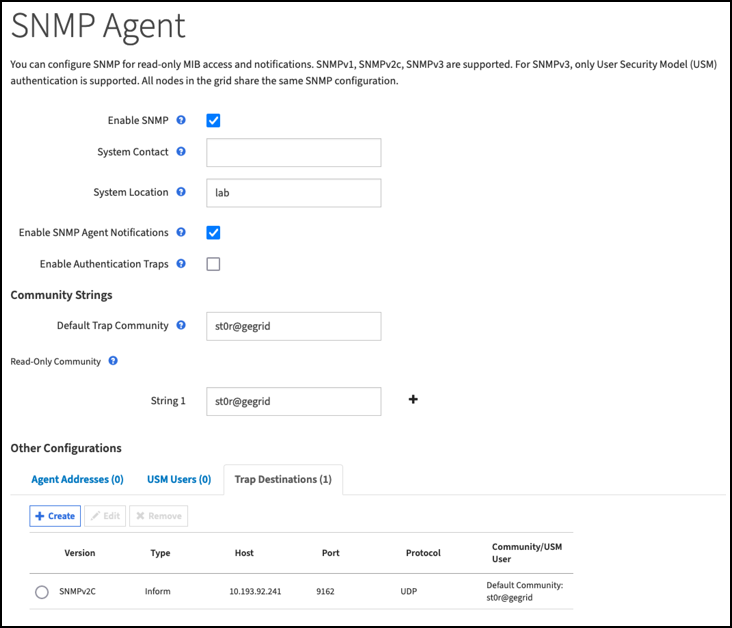Datadog SNMP configuration
 Suggest changes
Suggest changes


By Aron Klein
Configure Datadog to collect StorageGRID snmp metrics and traps.
Configure Datadog
Datadog is a monitoring solution providing metrics, visualizations, and alerting. The following configuration was implemented with linux agent version 7.43.1 on an Ubuntu 22.04.1 host deployed local to the StorageGRID system.
Datadog Profile and Trap files Generated from StorageGRID MIB file
Datadog provides a method for converting product MIB files into datadog reference files required to map the SNMP messages.
This StorageGRID yaml file for Datadog Trap resolution mapping generated following the instruction found here.
Place this file in /etc/datadog-agent/conf.d/snmp.d/traps_db/ +
-
-
md5 checksum 42e27e4210719945a46172b98c379517 +
-
sha256 checksum d0fe5c8e6ca3c902d054f854b70a85f928cba8b7c76391d356f05d2cf73b6887 +
-
This StorageGRID profile yaml file for Datadog metrics mapping generated following the instruction found here.
Place this file in /etc/datadog-agent/conf.d/snmp.d/profiles/ +
-
Download the profile yaml file +
-
md5 checksum 72bb7784f4801adda4e0c3ea77df19aa +
-
sha256 checksum b6b7fadd33063422a8bb8e39b3ead8ab38349ee0229926eadc8585f0087b8cee +
-
SNMP Datadog configuration for Metrics
Configuring SNMP for metrics can be managed in two ways. You can configure for auto-discovery by providing a network address range containing the StorageGRID system(s), or define the IP's of the individual devices. The configuration location is different based on the decision made. Auto-discovery is defined in the datadog agent yaml file. Explicit device definitions are configured in the snmp configuration yaml file. Below are examples of each for the same StorageGRID system.
Auto-discovery
configuration located in /etc/datadog-agent/datadog.yaml
listeners:
- name: snmp
snmp_listener:
workers: 100 # number of workers used to discover devices concurrently
discovery_interval: 3600 # interval between each autodiscovery in seconds
loader: core # use core check implementation of SNMP integration. recommended
use_device_id_as_hostname: true # recommended
configs:
- network_address: 10.0.0.0/24 # CIDR subnet
snmp_version: 2
port: 161
community_string: 'st0r@gegrid' # enclose with single quote
profile: netapp-storagegridIndividual devices
/etc/datadog-agent/conf.d/snmp.d/conf.yaml
init_config:
loader: core # use core check implementation of SNMP integration. recommended
use_device_id_as_hostname: true # recommended
instances:
- ip_address: '10.0.0.1'
profile: netapp-storagegrid
community_string: 'st0r@gegrid' # enclose with single quote
- ip_address: '10.0.0.2'
profile: netapp-storagegrid
community_string: 'st0r@gegrid'
- ip_address: '10.0.0.3'
profile: netapp-storagegrid
community_string: 'st0r@gegrid'
- ip_address: '10.0.0.4'
profile: netapp-storagegrid
community_string: 'st0r@gegrid'SNMP configuration for traps
The configuration for SNMP traps is defined in the datadog configuration yaml file /etc/datadog-agent/datadog.yaml
network_devices:
namespace: # optional, defaults to “default”.
snmp_traps:
enabled: true
port: 9162 # on which ports to listen for traps
community_strings: # which community strings to allow for v2 traps
- st0r@gegridExample StorageGRID SNMP configuration
The SNMP agent in your StorageGRID system is located under the configuration tab, Monitoring column. Enable SNMP and enter the desired information. If you wish to configure traps, select the "Traps Destinations" and Create a destination for the Datadog agent host containing the trap configuration.



